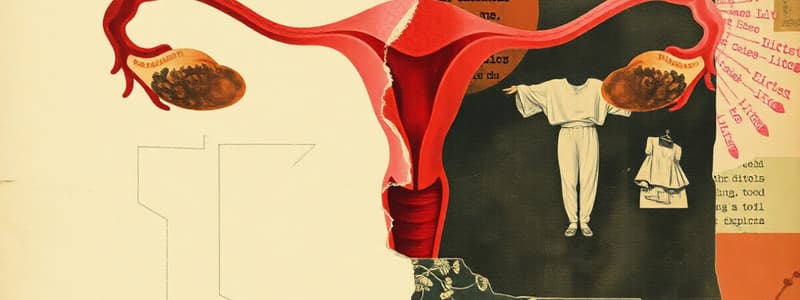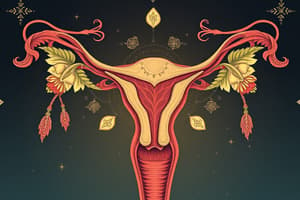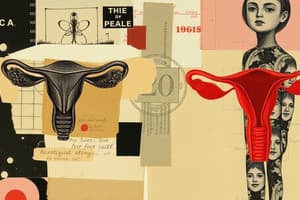Podcast
Questions and Answers
Which of the following statements accurately describes the relationship between the follicular and luteal phases of the menstrual cycle?
Which of the following statements accurately describes the relationship between the follicular and luteal phases of the menstrual cycle?
- Variations in the length of the menstrual cycle are mainly attributed to changes in the duration of the follicular phase. (correct)
- The luteal phase primarily dictates the length of the menstrual cycle, while the follicular phase remains constant.
- The length of the follicular phase is inversely proportional to the length of the luteal phase, maintaining a consistent total cycle length.
- Both the follicular and luteal phases exhibit similar degrees of variability in duration across different menstrual cycles.
During the early follicular phase, what is the specific role of the thecal cells in the ovaries, and how does this relate to estrogen production?
During the early follicular phase, what is the specific role of the thecal cells in the ovaries, and how does this relate to estrogen production?
- Thecal cells produce progesterone, which then stimulates the granulosa cells to produce estrogen.
- Thecal cells directly convert androgens into estrogen, leading to a rapid increase in estrogen levels.
- Thecal cells secrete FSH, which in turn stimulates the granulosa cells to produce androgens and subsequently estrogen.
- Thecal cells produce androgens under the influence of LH, which are then converted to estrogen by granulosa cells. (correct)
What distinguishes the dominant follicle from other developing follicles during the follicular phase of the menstrual cycle?
What distinguishes the dominant follicle from other developing follicles during the follicular phase of the menstrual cycle?
- The dominant follicle is less sensitive to FSH, allowing other follicles to catch up in development.
- The dominant follicle is the only follicle that produces androgens, suppressing estrogen production.
- The dominant follicle is the first to undergo atresia, ensuring only one ovum is released.
- The dominant follicle secretes more estradiol than androgens, leading to a positive feedback effect. (correct)
Following ovulation, what is the primary function of the corpus luteum, and how does this contribute to the regulation of the menstrual cycle?
Following ovulation, what is the primary function of the corpus luteum, and how does this contribute to the regulation of the menstrual cycle?
Which of the following describes a characteristic of the granulosa cells within a mature follicle?
Which of the following describes a characteristic of the granulosa cells within a mature follicle?
A researcher is investigating a new drug that aims to prolong the luteal phase in women with a history of recurrent miscarriages. Which hormonal effect of the drug would be most indicative of its success?
A researcher is investigating a new drug that aims to prolong the luteal phase in women with a history of recurrent miscarriages. Which hormonal effect of the drug would be most indicative of its success?
A woman experiencing irregular menstrual cycles visits a clinic. Blood tests reveal consistently low levels of LH and FSH, but normal levels of estradiol. Which of the following ovarian processes is most likely to be impaired?
A woman experiencing irregular menstrual cycles visits a clinic. Blood tests reveal consistently low levels of LH and FSH, but normal levels of estradiol. Which of the following ovarian processes is most likely to be impaired?
In a hypothetical scenario, a drug is developed that selectively inhibits the aromatase enzyme in granulosa cells. What direct effect would this drug have on the menstrual cycle?
In a hypothetical scenario, a drug is developed that selectively inhibits the aromatase enzyme in granulosa cells. What direct effect would this drug have on the menstrual cycle?
What key characteristic distinguishes the dominant follicle from other developing follicles during the follicular phase?
What key characteristic distinguishes the dominant follicle from other developing follicles during the follicular phase?
How does the hormonal environment in the early follicular phase contribute to the selection of a dominant follicle?
How does the hormonal environment in the early follicular phase contribute to the selection of a dominant follicle?
What is the primary role of LH during the luteal phase, and how does this affect hormone production?
What is the primary role of LH during the luteal phase, and how does this affect hormone production?
How does the shift from estradiol dominance in the follicular phase to progesterone dominance in the luteal phase affect LH pulse patterns, and what is the significance of this change?
How does the shift from estradiol dominance in the follicular phase to progesterone dominance in the luteal phase affect LH pulse patterns, and what is the significance of this change?
During the transition from the luteal phase to the early follicular phase, what hormonal changes initiate a new menstrual cycle?
During the transition from the luteal phase to the early follicular phase, what hormonal changes initiate a new menstrual cycle?
How does the positive feedback mechanism of estradiol contribute to ovulation?
How does the positive feedback mechanism of estradiol contribute to ovulation?
In the early follicular phase, how does the interplay between FSH, estradiol, and the developing follicles determine which follicle will become dominant?
In the early follicular phase, how does the interplay between FSH, estradiol, and the developing follicles determine which follicle will become dominant?
What is the role of granulosa cells in the follicular phase, and how do they contribute to the selection of the dominant follicle?
What is the role of granulosa cells in the follicular phase, and how do they contribute to the selection of the dominant follicle?
How do hormone treatments stimulate the development of multiple follicles, contrasting with the natural menstrual cycle?
How do hormone treatments stimulate the development of multiple follicles, contrasting with the natural menstrual cycle?
What is the significance of pulsatile hormone secretion during the menstrual cycle, and how does progesterone influence LH pulse patterns?
What is the significance of pulsatile hormone secretion during the menstrual cycle, and how does progesterone influence LH pulse patterns?
Flashcards
Menstrual Cycle
Menstrual Cycle
The periodic biological changes in female reproductive system, typically lasting 28 days.
Follicular Phase
Follicular Phase
The first half of the menstrual cycle before ovulation, marked by follicle growth.
Luteal Phase
Luteal Phase
The second half of the menstrual cycle after ovulation, characterized by the presence of the corpus luteum.
Luteinizing Hormone (LH)
Luteinizing Hormone (LH)
Signup and view all the flashcards
Follicle-Stimulating Hormone (FSH)
Follicle-Stimulating Hormone (FSH)
Signup and view all the flashcards
Corpus Luteum
Corpus Luteum
Signup and view all the flashcards
Estrogen
Estrogen
Signup and view all the flashcards
Negative Feedback
Negative Feedback
Signup and view all the flashcards
Dominant Follicle
Dominant Follicle
Signup and view all the flashcards
FSH (Follicle Stimulating Hormone)
FSH (Follicle Stimulating Hormone)
Signup and view all the flashcards
Granulosa Cells
Granulosa Cells
Signup and view all the flashcards
LH (Luteinizing Hormone)
LH (Luteinizing Hormone)
Signup and view all the flashcards
Estrogen's Role
Estrogen's Role
Signup and view all the flashcards
Negative Feedback Mechanism
Negative Feedback Mechanism
Signup and view all the flashcards
Positive Feedback Effect
Positive Feedback Effect
Signup and view all the flashcards
Study Notes
Female Reproductive Endocrinology: Menstrual Cycle Overview
- The menstrual cycle is a roughly 28-day cycle, though variable.
- It's divided into follicular and luteal phases.
- Follicular phase (first half) is more variable in length (10-14+ days).
- Luteal phase (second half) is more consistent.
Hormonal Changes
- LH and FSH peak at ovulation.
- Estrogen rises before ovulation.
- Progesterone is low in the follicular phase, increasing in the luteal phase.
Control Mechanisms
- The interplay between the ovary and pituitary gland controls the cycle.
Ovarian Events: Follicular Phase
- Many follicles develop, containing ova. A woman starts with ~100,000 primordial follicles.
- One follicle, the dominant follicle, matures.
- The dominant follicle produces more estradiol than androgens.
- High estradiol creates positive feedback leading to ovulation.
Ovarian Events: Luteal Phase
- After ovulation, the corpus luteum develops.
- The corpus luteum produces progesterone and estradiol.
- High progesterone results in negative feedback.
Ovarian Structures
- Primordial follicles: Numerous follicles with ova.
- Developing follicles: Developing follicles in the follicular phase.
- Dominant follicle: Mature follicle releasing the ovum.
- Corpus luteum: Structure from the remaining follicle after ovulation. It matures then regresses in 14 days.
Follicular Phase Details
- Early Follicular Phase:
- LH stimulates thecal cells to produce androgens.
- FSH stimulates granulosa cells to convert androgens to estrogen, a key conversion that occurs in those cells.
- Mature Follicle:
- LH and FSH stimulate follicle growth.
- Estrogens trigger a local positive feedback loop, increasing FSH receptors, amplifying aromatase and estrogen production in granulosa cells.
- Dominant Follicle:
- Higher aromatase and estrogen production makes it dominant.
- It efficiently converts androgens to estrogen while minimizing androgens.
- Estrogen further enhances FSH receptors, boosting follicle growth and aromatase levels.
- FSH promotes granulosa cell proliferation and nutrient production for the ovum.
- Granulosa cells also produce inhibin (a small FSH regulator).
Key Follicular Phase Takeaways
- LH drives androgen production, FSH drives estrogen production.
- High estrogen results in heightened FSH receptor sensitivity leading to a dominant follicle.
Luteal Phase Summary
- FSH decreases in importance.
- LH stimulates both cell types in the corpus luteum.
- The primary product is progestin, then androgen and estrogen.
- Both cell types make estrogen and progesterone under LH stimulation.
Hormonal Changes and Feedbacks
- Early Follicular: High FSH, multiple follicle development, estradiol produced, negative feedback suppresses FSH. Dominant follicle becomes FSH-responsive, less FSH for other follicles which regress.
- Mid-Cycle (Ovulation): Dominant follicle's high estradiol creates positive feedback, resulting in a large LH and FSH surge and ovulation.
- Luteal: Corpus luteum produces estrogen & progesterone; negative feedback decreases LH & FSH levels. Corpus luteum regression decreases estrogen & progesterone, which lifts negative feedback, letting FSH & LH increase.
Pulsatile Hormone Secretion
- Follicular: Frequent, low-amplitude LH pulses with estradiol.
- Luteal: Slow LH & FSH pulses due to progesterone's negative feedback.
Menstrual Cycle Summary
- Early Follicular: FSH stimulates multiple follicles, LH stimulates androgen production, FSH stimulates estrogen production. Smaller follicles regress.
- Dominant Follicle: Estradiol from dominant follicle increases FSH sensitivity, promoting further estrogen production.
- Ovulation: High levels of estrogen create positive feedback, leading to a surge in LH & FSH, triggering ovulation.
- Luteal Phase: Corpus luteum produces progesterone and estradiol, causing negative feedback on LH & FSH; corpus luteum eventually regresses, decreasing both and allowing for another cycle.
Studying That Suits You
Use AI to generate personalized quizzes and flashcards to suit your learning preferences.



